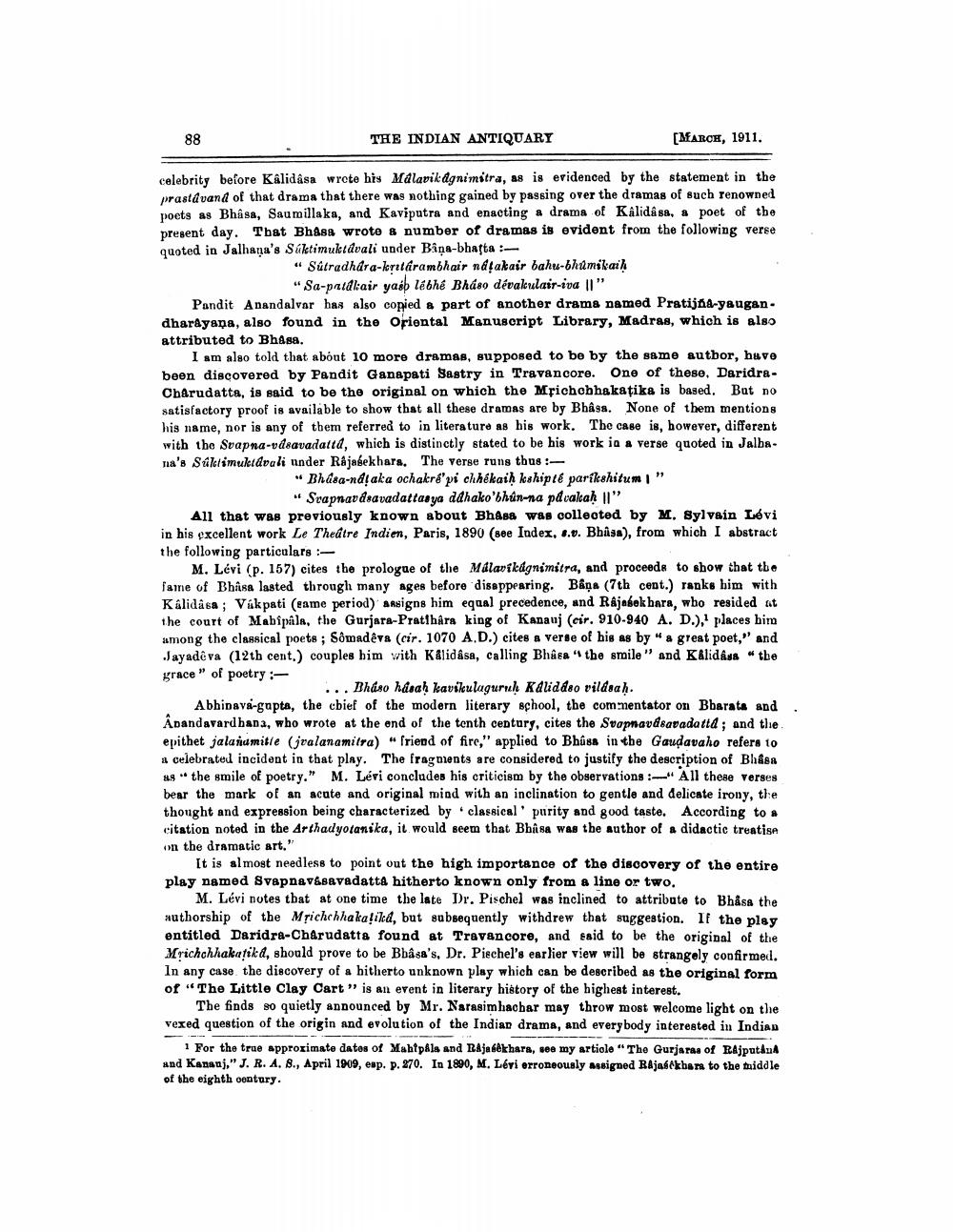________________
88
THE INDIAN ANTIQUARY
[MARCH, 1911.
celebrity before Kalidasa wrote his Malavik dgnimitra, as is evidenced by the statement in the prastavand of that drama that there was nothing gained by passing over the dramas of such renowned poets as Bhîsa, Saumillaka, and Kaviputra and enacting a drama of Kalidasa, a poet of the present day. That Bhasa wrote a number of dramas is evident from the following verse quoted in Jalhana's Súktimukıdvali under Biņa-bhatta :
· Sútradhdra-korttárambhair ndtakair bahu-bhumikail
"Sa-paldlair yabb lébhe Bhúso dévalculair-iva 11" Pandit Anandalvar has also copied & part of another drama named Pratijn-yaugandharayana, also found in the Oriental Manuscript Library, Madras, which is also attributed to Bhisa.
I am also told that about 10 more dramas, supposed to be by the same autbor, huve been discovered by Pandit Ganapati Sastry in Travancore. One of these, DaridraCharudatta, is said to be the original on which the Mfichobhakatika is based. But no satisfactory proof is available to show that all these dramas are by Bhâss. None of them mentions his name, nor is any of them referred to in literature as his work. The case is, however, different with the Svapna-vdsavadattd, which is distinctly stated to be his work is a verse quoted in Jalbama's Shllimuk dvali under Rajasekhara. The verge runs thus :
"Bhasa-ndļaka ochakré'pi chhékaiḥ kshipt& parikshitumi"
- Svapnavdsavadattasya ddhako'bhún-na pdvalcah II" All that was previously known about Bhasa was collected by M. Sylvain Levi in his excellent work Le Theatre Indien, Paris, 1890 (see Index, 6.. Bhisa), from which I abstract the following particulars :
M. Lévi (p. 157) cites the prologue of the Malavikugnimitra, and proceeds to show that the fame of Bhisa lasted through many ages before disappearing. Bâņa (7th cent.) ranks him with Kalidasa ; Vákpati (eame period) assigns him equal precedence, and Rajabek bara, who resided at the court of Mabipala, the Gurjara-Pratibâra king of Kanauj (cir. 910-940 A. D.), places bim among the classical poets ; Sômadeva (cir. 1070 A.D.) cites a verse of his as by a great poet," and Jayadeva (12th cent.) couples him with Kalidasa, calling Bhâea " the smile" and Kalidass the grace" of poetry :
... Bhaso hasah kavikulaguruh Kalid doo vildsah. Abhinava-gapta, the cbief of the modern literary school, the commentator on Bbarate and Apandavardhana, who wrote at the end of the tenth century, cites the Svapnavåsavadattd; and the epithet jalanamitie (jualanamitra) " friend of fire," applied to Bhúss in the Gaudavaho refers to a celebrated incident in that play. The fragments are considered to justify the description of Bhasa us the smile of poetry." M. Lévi concludes his criticism by the observations: All these verses bear the mark of an acute and original mind with an inclination to gentle and delicate irony, the thought and expression being characterized by classical' purity and good taste. According to a citation noted in the Arthadyotanika, it would seem that Bhisa was the author of a didactic treatise on the dramatic art."
It is almost needless to point out the high importance of the discovery of the entire play named Svapnav savadatta hitherto known only from a line or two.
M. Lévi notes that at one time the late Dr. Pischel was inclined to attribute to Bhâss the authorship of the Msichchhakaļild, but subsequently withdrew that suggestion. If the pley entitled Daridra-Charudatta found at Travancore, and said to be the original of the Mrichchhakatika, should prove to be Bbâsa's, Dr. Piechel's earlier view will be strangely confirmed. In any case the discovery of a hitherto unknown play which can be described as the original form of "The Little Clay Cart" is an event in literary history of the highest interest.
The finds so quietly announced by Mr. Narasimhachar may throw most welcome light on the vexed question of the origin and evolution of the Indian drama, and everybody interested in Indian
For the true approximate datos of Mahtpala and Rajasekhara, see my artiolo "The Gurjaras of Rajputu and Kananj." J. R. A. 8., April 1909, eap. p. 270. In 1890, M. Lévi orroneously assigned Rajasekhar to the middle of the eighth century.




